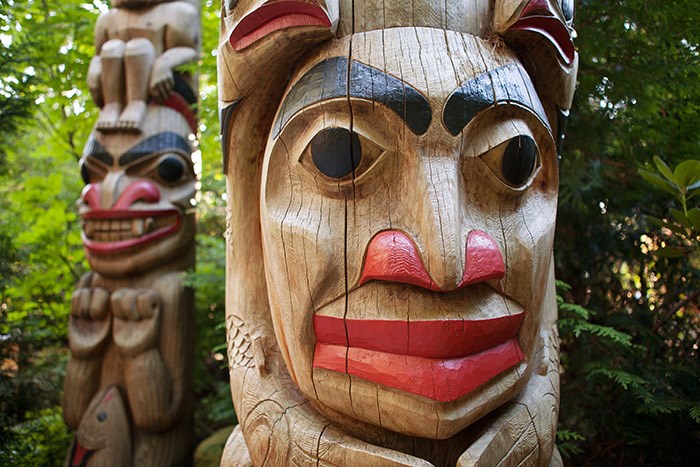 Photo: Capilano Suspension Bridge
Photo: Capilano Suspension Bridge
As part of the traditional territories of the Musqueam, Tsleil-Waututh and Squamish nations, the Greater Vancouver area is rich in Indigenous artefacts—chief among them totem poles.
Totem poles are carved wood monuments that depict symbols, animals, and supernatural forms and document or commemorate Indigenous history, legends, people, or events. They’re typically made from red cedar and often showcase crest animals to denote clan memberships or families, including thunderbirds, wolves, grizzly bears, eagles, and killer whales.
These stunning parts of Vancouver’s living history could be spotted on your morning hike, during your afternoon golf game, or on your day out at Capilano Suspension Bridge Park in North Van. We’ve put together an interactive map to ensure that you don’t miss an opportunity to spot one.
Capilano Suspension Bridge Park
View this post on Instagram
Because the 230-foot-high suspension bridge often gets all the attention, not everyone knows that Capilano Suspension Bridge Park has the largest collection of privately owned totem poles in Vancouver. Visitors can find century-old poles from the Coast Salish peoples in the Totem Park area. Haida, Tsimshian and Tlingit poles were carved on-site and placed in the park’s Kia’palano area over the past 20 years as part of a local tradition.
Vancouver Airport
A series of original Indigenous work was commissioned for the interior of the airport, while other pieces were sourced, including three cedar totem poles that remain part of the Museum of Vancouver’s permanent collection. The totems were originally created by Gitksan carvers Walter Harris and Earl Muldon in the 1970s, in a style specific to the Gitanmaax School of Art on the Skeena River.
While these ‘Ksan poles are currently in storage until construction at the airport is complete, there’s also a Celebrating Flight pole in the Graham Clarke Atrium. Carved in 2007 by Don Yeomans, this painted totem blends Haida forms (like the Creator Raven on top) and traditions with different cultures (note the Chinese characters) to honour humankind for transcending earthbound limitations and creating the magic of flight.
Brockton Point at Stanley Park
View this post on Instagram
This mixed crew of totem poles is probably the most recognized set in B.C. Four totems were brought from Vancouver Island’s Alert Bay and originally placed at Lumberman’s Arch in 1924. Others were purchased in the 1920s and ‘30s, including the Skedans Mortuary Pole—which has now been replaced with a replica, as the original was returned to Haida Gwaii. The rest of the original poles have since been sent to local museums for safe keeping and replaced with replicas as well. The ninth totem pole, and most recent addition in 2009, was carved by Robert Yelton of the Squamish Nation.
Old Surrey city hall grounds
The Surrey Columbian Centennial Totem Pole is one of the oldest artworks in the city’s collection and was placed as a tribute to the local Indigenous population during Canada’s centennial in 1967. Kwakwaka’wakw carver John Edward “Ted” Neel featured four figures—an eagle, bear, beaver, and frog—in his people’s traditional colours. Three other poles were carved as part of this centennial totem pole project (in Coquitlam, New Westminster, and Burnaby), one of which is now in storage.
Poirier Community Centre (Coquitlam)
View this post on Instagram
Carved by Neel, along with Lloyd Wadhams and Robert (Bob) Whonnock, this totem depicts a thunderbird with a bear in its belly, a raven with a salmon in its beak, and a killer whale with a man on its back. Set your GPS for 630 Poirier Street to take in this majestic sculpture.
The Haida House at the Museum of Anthropology
View this post on Instagram
The Museum of Anthropology houses many totem poles and hundreds of totem fragments from around B.C. There are also standing poles surrounding its outdoor Haida house, carved by Bill Reid and Doug Cranmer. The original Reid/Cranmer pole was moved inside to save it from weather damage, but it was replaced with a “Respect to Bill Reid Pole” by Haida master carver James “Jim” Hart.
White Rock Beach
The City of White Rock and the White Rock RCMP have a strong, respectful relationship with the Semiahmoo First Nation. In 1999, the local community raised the funds to place two totem poles on White Rock Beach as a symbol of reconciliation. The site was later blessed by the Semiahmoo people and in 2009, the whole Totem Plaza was dedicated to Grand Chief Bernard Robert Charles, who was the Chief of the Semiahmoo First Nation from 1963-1996.
University of British Columbia
View this post on Instagram
To represent the history of Indigenous peoples in Canada before, during, and after the Indian Act and residential school era, the University of British Columbia installed a Reconciliation Pole in 2017 on the southern end of campus. One of the pole’s most striking features is a depiction of a residential schoolhouse that’s been hammered with thousands of copper nails by actual residential school survivors and their families. The nails commemorate the children who died in residential schools. The pole took two years to make and was also carved by Jim Hart, along with assistant carvers and painters.
From the expansive collection at Capilano Suspension Bridge Park to the trio that greet visitors at YVR Airport, these totem poles are a tribute to the rich history of Vancouver’s Indigenous peoples. The next time you’re visiting any of these sites, keep an eye out for these impressive and powerful works of art.


